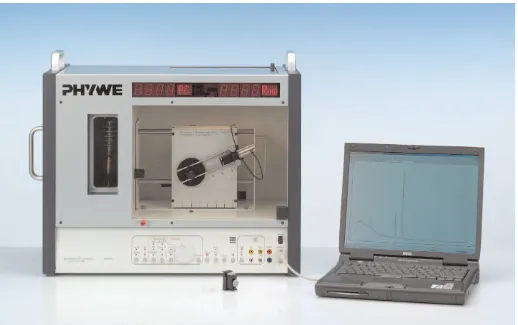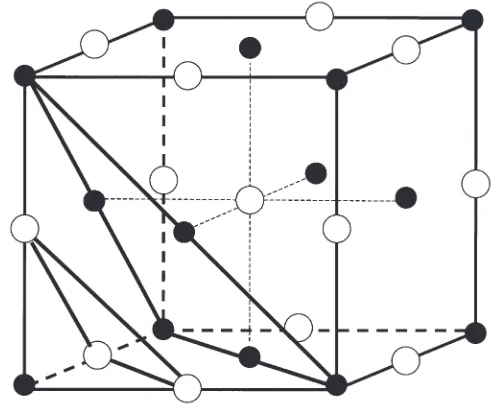249 PHYWE Systeme GmbH &Co. KG · D - 37070 Göttingen Laboratory Experiments Physics
Principle:
Polychromatic X-rays are to be directed against NaCl monocrystals with different orientations. The spacing between the lattice planes of each monocrystals then to be determined by analyzing the wave-length-dependent intensity of the reflected radiation.
3. The planes of reflection and their Miller indices are to be found.
X-ray intensity of copper as a function of the glancing angle: NaCl monocrystal with different
orientations as Bragg-analyzer: 1-(100); 2-(110); 3-(111)
Tasks:
1. NaCl monocrystals with the orien-tations (100), (110) and (111) are each to be separately used to record an intensity spectrum of the polychromatic radiation em-anated by the X-ray tube. 2. The Bragg angles of the
character-istic radiations are to be deter-mined from the spectra, and the distances between lattice planes calculated for each orientation.
What you can learn about …
Characteristic X-ray radiation Energy levels
Crystal structures Reciprocal lattice Miller indices Bragg scattering Atomic form factor Structure factor
X-ray basic unit, 35 kV 09058.99 1 Goniometer for X-ray unit, 35 kV 09058.10 1 Plug-in module with Cu X-ray tube 09058.50 1 Counter tube, type B 09005.00 1 Universal crystal holder 09058.02 1 Sodium chloride monocrystals, set of 3 09058.01 1
Recording equipment:
XYt recorder 11416.97 1
Connecting cable, l= 100 cm, red 07363.01 2 Connecting cable, l= 100 cm, blue 07363.04 2 or
Software X-ray unit, 35 kV 14407.61 1 RS232 data cable 14602.00 1 PC, Windows® 95 or higher
What you need:
Complete Equipment Set, Manual on CD-ROM included
Examination of the structure of NaCl monocrystals
Fig. 1: Experimental set-up for the examination of the structure of NaCl monocrystals Related topics
Characteristic X-ray radiation,, energy levels, crystal structures, reciprocal lattice, Miller indices, Bragg scattering, atomic form factor, structure factor.
Principle
Polychromatic X-rays are to be directed against NaCl monocrys-tals with different orientations. The spacing between the lattice planes of each monocrystals then to be determined by analyz-ing the wavelength-dependent intensity of the reflected radia-tion.
Equipment
X-ray basic unit, 35 kV 09058.99 1
Goniometer for X-ray unit, 35 kV 09058.10 1 Plug-in module with Cu X-ray tube 09058.50 1
Counter tube, type B 09005.00 1
Universal crystal holder 09058.02 1
Sodium chloride monocrystals, set of 3 09058.01 1
Recording equipment:
XYt recorder 11416.97 1
Connecting cable, l = 100 cm, red 07363.01 2 Connecting cable, l = 100 cm, blue 07363.04 2 or
Software X-ray unit, 35 kV 14407.61 1
RS232 data cable 14602.00 1
PC, Windows®95 or higher
Tasks
1. NaCl monocrystals with the orientations (100), (110) and (111) are each to be separately used to record an intensity spectrum of the polychromatic radiation emanated by the X-ray tube.
2. The Bragg angles of the characteristic radiations are to be determined from the spectra, and the distances between lat-tice planes calculated for each orientation.
3. The planes of reflection and their Miller indices are to be found.
Set-up and procedure
Set up the experiment as shown in Fig. 1. Fix the diaphragm tube with 2 mm diameter aperture in the X-ray outlet tube.With the X-ray unit switched off, connect the goniometer and the counter tube to the appropriate sockets in the base plate of the experimenting area. Set the goniometer block to the middle position and the counter tube to the right stop.
The following settings are recommended for the recording of the spectra:
— Auto and Coupling mode
— Gate time 2 s; Angle step width 0.1° — Scanning range: 3°-55°
Theory and evaluation
NaCl monocrystals have a face centred cubic lattice (fcc) (see Fig. 2). The basis of the cell is an Na+ion at 000 and a Cl-ion at 1/
2 1/2 1/2. For a cubic crystal with a lattice constant a, the fol-lowing is valid for the distances d(h,k,l) of the individual lattice planes (h,k,l):
(1)
When a beam of X-rays of wavelength limpinges on a parallel layer of lattice planes (Fig. 3) at glancing angle q, then, accord-ing to Bragg, constructive reflection occurs when condition (2) is fulfilled:
2d sin q= n l; (n= 1,2,3,…) (2)
The relative intensities of all reflections are determined by the scattering power and position of the individual atoms in the unit cell of the crystal, however, and are described by the structure factor F(h,k,l):
(3)
where fn= the atomic form factor, and un, vnand wn= the coor-dinates of the natoms of a unit cell.
The total intensity of the scattered reflections is given by:
(4)
With the atom positions 000; 01/
2 1/2; 1/201/2; 1/2 1/20 as the basis of an fcc lattice, it follows from (3) that F= 0 when the h,k,l triplet contains even and odd numbers, and F= 4fwhen all indices are either even or odd.
IF* · F 0F1h,k,l2 02
Phywe series of publications • Laboratory Experiments • Physics • © PHYWE SYSTEME GMBH & Co. KG • D-37070 Göttingen 25413-00
Fig. 2: NaCl crystal structure with drawn-in (111) and (222) lat-tice planes. Na+ions =
•
; Cl-ions = O.The lattice constant for NaCl is a= 564 nm. We therefore find the following distances between lattice planes:
d(200) = 282.0 pm; d(220) = 199.4 pm; d(111) = 325.6 pm. Figs. 4a-4c show the spectra of NaCl crystals with the orienta-tions (100), (110) and (111).
Table 1 lists the Bragg angles calculated from the spectra, and the lattice planes calculated using (2).
The very good agreement between the value for the distance between the (100) lattice planes found practically and that cal-culated using (2) confirm the fact that ionic crystal can be very exactly split parallel to the (100) planes. The not quite so good agreement for crystals with (110) and (111) orientations is due to an inaccuracy of a few 1/10° in the crystallographic directions. It can be further seen that an evaluation of the reflections lead-ing to agreement with the measured values is only possible when the assumption is made, that only lattice planes with either even or odd Miller indices interfere constructively.
The spectrum of the NaCl crystal with (111) orientation is worthy of attention. The intensity of the first order (111) reflection is unusual in that it is distinctly lower than that in the second order. This is because, in this orientation, the lattice planes are alter-nately occupied by either only Cl- ions or only with Na+ ions (Fig. 2). As these two ions have different scattering powers (atomic form factors), the intensities of their reflections differ.
Fig. 3: Bragg scattering on the lattice planes
Fig. 4: X-ray intensity of copper as a function of the glancing angle: NaCl monocrystal with different orientations as Bragg-analyzer:
Phywe series of publications • Laboratory Experiments • Physics • © PHYWE SYSTEME GMBH & Co. KG • D-37070 Göttingen 25413-00

